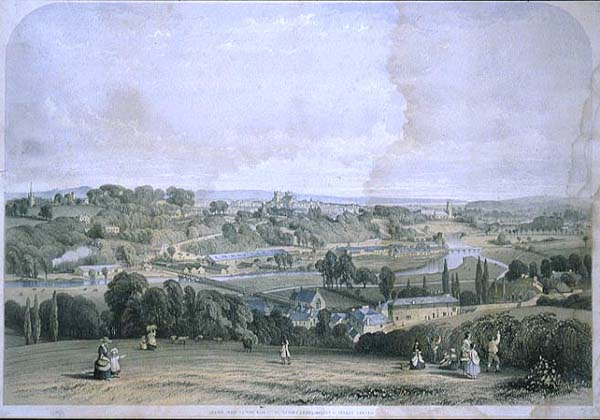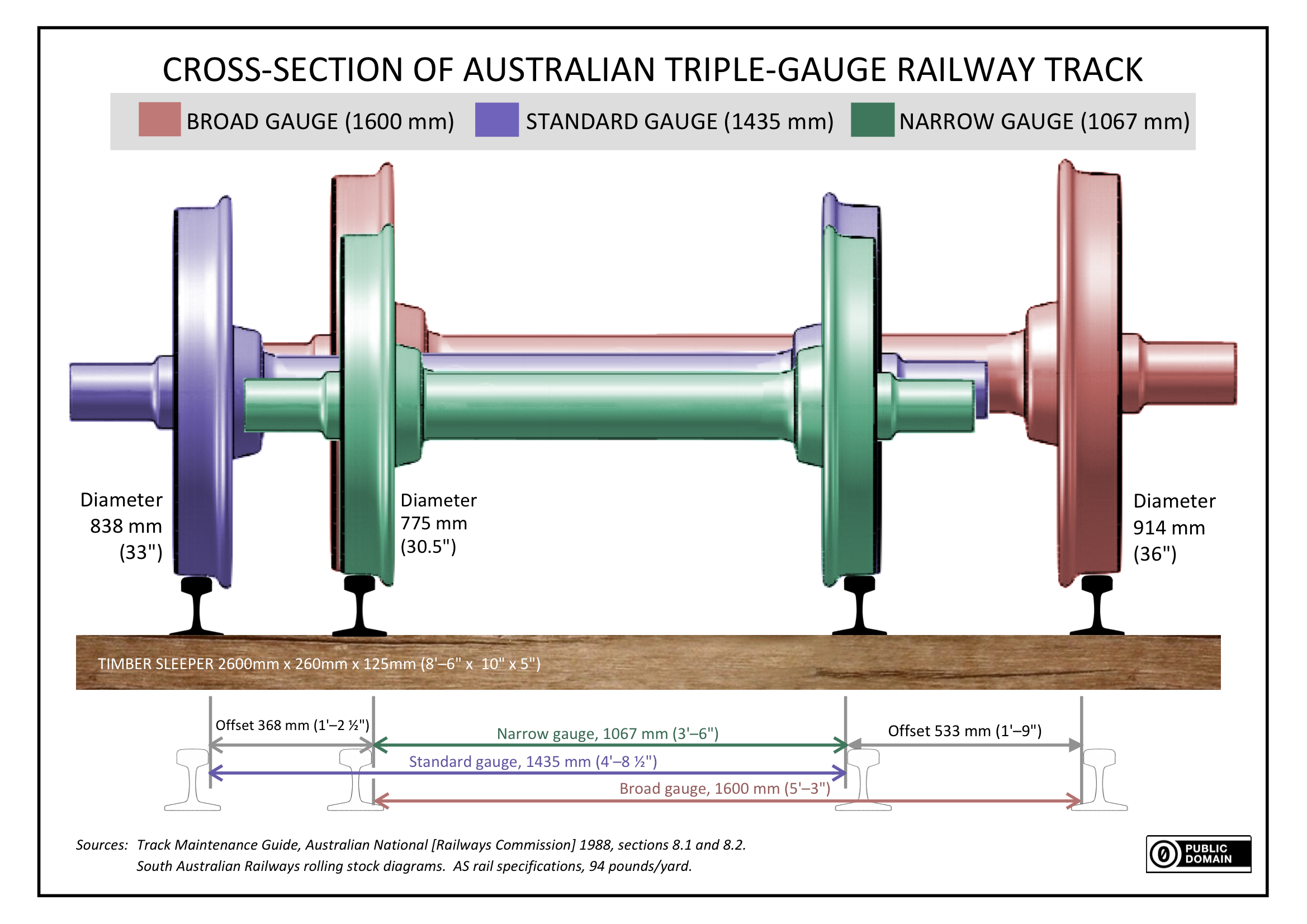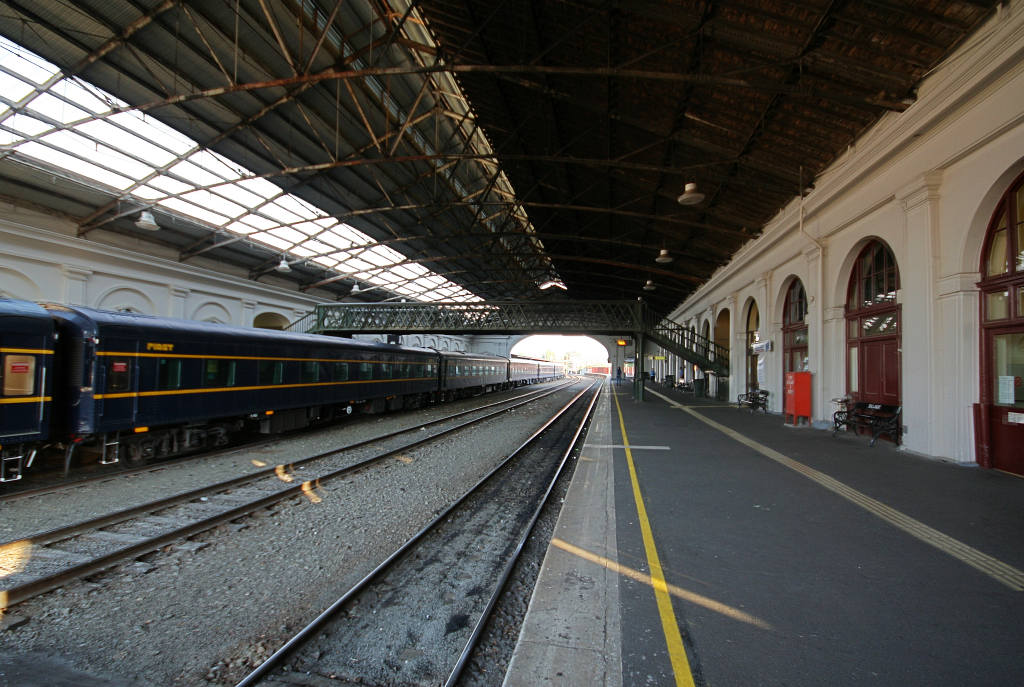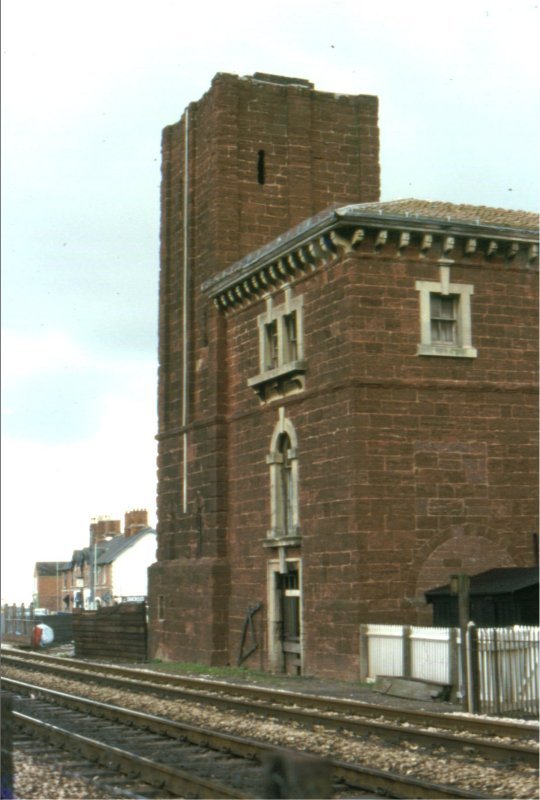|
Exeter St Davids
Exeter St Davids railway station is the principal and largest railway station in Exeter, also the second-busiest station in Devon. It is from the zero point at , from where trains travel through Exeter to and . The station is also served by trains from via and long distance services to , , and other places in the North. Local services operate on the Avocet Line to , the Riviera Line to , the Tarka Line to and Dartmoor Line to . It is managed by Great Western Railway and served by trains operated by Great Western Railway, South Western Railway and CrossCountry. History The station was opened on 1 May 1844 by the Bristol and Exeter Railway (B&ER). The station was designed by Isambard Kingdom Brunel and was one of his single-sided stations which meant that the two platforms were both on the eastern side of the line. This side is nearer the city and so very convenient for passengers travelling into Exeter, but did mean that many trains had to cross in front of others. T ... [...More Info...] [...Related Items...] OR: [Wikipedia] [Google] [Baidu] |
Exeter
Exeter ( ) is a City status in the United Kingdom, cathedral city and the county town of Devon in South West England. It is situated on the River Exe, approximately northeast of Plymouth and southwest of Bristol. In Roman Britain, Exeter was established as the base of Legio II Augusta under the personal command of Vespasian. Exeter became a religious centre in the Middle Ages. Exeter Cathedral, founded in the mid 11th century, became Anglicanism, Anglican in the 16th-century English Reformation. Exeter became an affluent centre for the wool trade, although by the First World War the city was in decline. After the Second World War, much of the city centre was rebuilt and is now a centre for education, business and tourism in Devon and Cornwall. It is home to two of the constituent campuses of the University of Exeter: Streatham Campus, Streatham and St Luke's Campus, St Luke's. The administrative area of Exeter has the status of a non-metropolitan district under the administ ... [...More Info...] [...Related Items...] OR: [Wikipedia] [Google] [Baidu] |
Goods Shed
A goods shed is a railway building designed for storing goods before, after, and during loading to and unloading from a train. A typical goods shed will have a track running through it to allow goods wagons to be unloaded under cover, although sometimes they were built alongside a track with possibly just a canopy over the door. There will also be a door to move goods to or from road wagons and vans, this sometimes is parallel to the rail track, or sometimes on the side opposite the rail track. Inside the shed will generally be a platform and sometimes a small crane to allow easier loading and unloading of wagons. Double track Some goods sheds had more than one track. If one were not adjacent to the unloading platform then the method of working the second siding would be to first empty the wagons adjacent to the platform, and then open the doors on their far side to access those on the second track. Planks or portable bridges were normally provided for this purpose. Conve ... [...More Info...] [...Related Items...] OR: [Wikipedia] [Google] [Baidu] |
Standard Gauge
A standard-gauge railway is a railway with a track gauge of . The standard gauge is also called Stephenson gauge (after George Stephenson), international gauge, UIC gauge, uniform gauge, normal gauge in Europe, and SGR in East Africa. It is the most widely used track gauge around the world, with about 55% of the lines in the world using it. All high-speed rail lines use standard gauge except High-speed rail in Russia, those in Russia, High-speed rail in Finland, Finland, High-speed rail in Uzbekistan, Uzbekistan, and some line sections in High-speed rail in Spain, Spain. The distance between the inside edges of the heads of the rails is defined to be 1,435 mm except in the United States, Canada, and on some heritage British lines, where it is defined in Imperial and US customary measurement systems, U.S. customary/Imperial units, British Imperial units as exactly "four feet eight and one half inches", which is equivalent to 1,435.1mm. History As railways developed and expa ... [...More Info...] [...Related Items...] OR: [Wikipedia] [Google] [Baidu] |
Dual Gauge
Dual gauge railroad track has three or four rails, allowing vehicles of two track gauges to run on it. Signalling and sidings are more expensive to install on dual gauge tracks than on two single gauge tracks. Dual gauge is used when there is not enough room for two single tracks or when tracks of two different gauges meet in marshalling yards or train stations. Background The rail gauge is the most fundamental specification of a railway. Rail tracks and Wheelset (rail transport), wheelsets are built within engineering tolerances that allow optimum lateral movement of the wheelsets between the rails. Pairs of rails that become too wide or narrow in gauge will cause derailments, especially if in excess of normal gauge-widening on curves. Given the requirement for gauge to be within very tight limits, when the designed distance between the pair of wheels on a wheelset differs even slightly from that of others on a railway, track must be built to two specific gauges. That is ... [...More Info...] [...Related Items...] OR: [Wikipedia] [Google] [Baidu] |
Consolidation (business)
In business, consolidation or amalgamation is the merger and acquisition of many smaller companies into a few much larger ones. In the context of financial accounting, ''consolidation'' refers to the aggregation of financial statements of a group company as consolidated financial statements. The taxation term of consolidation refers to the treatment of a corporate group, group of companies and other entities as one entity for tax purposes. Under the Halsbury's Laws of England, ''amalgamation'' is defined as "a blending together of two or more undertakings into one undertaking, the shareholders of each blending company, becoming, substantially, the shareholders of the blended undertakings. There may be amalgamations, either by transfer of two or more undertakings to a new company or the transfer of one or more companies to an existing company". Overview Consolidation is the practice, in business, of legally combining two or more organizations into a single new one. Upon consolidati ... [...More Info...] [...Related Items...] OR: [Wikipedia] [Google] [Baidu] |
Level Crossing
A level crossing is an intersection where a railway line crosses a road, Trail, path, or (in rare situations) airport runway, at the same level, as opposed to the railway line or the road etc. crossing over or under using an Overpass#Railway, overpass or tunnel. The term also applies when a light rail line with separate Right-of-way (railroad), right-of-way or reserved track crosses a road in the same fashion. Other names include railway level crossing, railway crossing (chiefly international), grade crossing or railroad crossing (chiefly American), road through railroad, criss-cross, train crossing, and RXR (abbreviated). There are more than 100,000 level crossings in Europe and more than 200,000 in North America. Road-grade crossings are considered incompatible with high-speed rail and are virtually non-existent in European high-speed train operations. File:The 5.20 for West Kirby leaving Hoylake - geograph.org.uk - 1503619.jpg, A level crossing at Hoylake, Merseyside, Engl ... [...More Info...] [...Related Items...] OR: [Wikipedia] [Google] [Baidu] |
Train Shed
A train shed is a building adjacent to a station building where the tracks and platforms of a railway station are covered by a roof. It is also known as an overall roof. Its primary purpose is to store and protect from the elements train cars not in use, The first train shed was built in 1830 at Liverpool's Crown Street railway station, Crown Street Station. The biggest train sheds were often built as an arch of glass and iron, while the smaller were built as normal pitched roofs. The train shed with the biggest single span ever built was that at the second Broad Street Station (Philadelphia), Philadelphia Broad Street Station, built in 1891. Types of train shed Early wooden train sheds The earliest train sheds were wooden structures, often with unglazed openings to allow smoke and steam to escape. The oldest part of Bristol Temple Meads railway station, Bristol Temple Meads is a particularly fine – and large – example, designed by Isambard Kingdom Brunel with mock-ha ... [...More Info...] [...Related Items...] OR: [Wikipedia] [Google] [Baidu] |
2008 At Exeter St Davids - Transfer Shed
8 (eight) is the natural number following 7 and preceding 9. Etymology English ''eight'', from Old English '', æhta'', Proto-Germanic ''*ahto'' is a direct continuation of Proto-Indo-European '' *oḱtṓ(w)-'', and as such cognate with Greek and Latin , both of which stems are reflected by the English prefix oct(o)-, as in the ordinal adjective ''octaval'' or ''octavary'', the distributive adjective is ''octonary''. The adjective ''octuple'' (Latin ) may also be used as a noun, meaning "a set of eight items"; the diminutive ''octuplet'' is mostly used to refer to eight siblings delivered in one birth. The Semitic numeral is based on a root ''*θmn-'', whence Akkadian ''smn-'', Arabic ''ṯmn-'', Hebrew ''šmn-'' etc. The Chinese numeral, written (Mandarin: ''bā''; Cantonese: ''baat''), is from Old Chinese ''*priāt-'', ultimately from Sino-Tibetan ''b-r-gyat'' or ''b-g-ryat'' which also yielded Tibetan '' brgyat''. It has been argued that, as the cardinal num ... [...More Info...] [...Related Items...] OR: [Wikipedia] [Google] [Baidu] |
Broad Gauge
A broad-gauge railway is a railway with a track gauge (the distance between the rails) broader than the used by standard-gauge railways. Broad gauge of , more known as Russian gauge, is the dominant track gauge in former Soviet Union countries (CIS states, Baltic states, Rail transport in Georgia (country), Georgia, Ukraine) and Rail transport in Mongolia, Mongolia. Broad gauge of , commonly known as five foot gauge, is mainly used in Rail transport in Finland, Finland. Broad gauge of , commonly known as Irish gauge, is the dominant track gauge in Ireland, the Australian state of Rail transport in Victoria, Victoria and Railways in Adelaide, Adelaide in South Australia and Rail transport in Brazil, passenger trains of Brazil. Broad gauge of , commonly known as Iberian gauge, is the dominant track gauge in Spain and Portugal. Broad gauge of , commonly known as Indian gauge, is the dominant track gauge in Indian Railways, India, Pakistan Railways, Pakistan, Bangladesh, Sri Lanka ... [...More Info...] [...Related Items...] OR: [Wikipedia] [Google] [Baidu] |
Cowley Bridge Junction
Cowley is a hamlet in the parish of Upton Pyne in Devon, England. Cowley church was built as a chapel of ease to Brampford Speke by Rohde Hawkins in 1867–8. It is chiefly notable for a fine three-arched bridge of classical design, built over the River Creedy in 1813-14 by James Green, pupil of John Rennie and surveyor to the county of Devon. Although so recent in date, the bridge has been scheduled as an ancient monument. Cowley Bridge Junction is a railway junction on the former Bristol and Exeter Railway, that allows access to the former North Devon Railway towards Barnstaple, now renamed the Tarka Line The Tarka Line, also known as the North Devon Line, is a local railway line in Devon, England, linking the city of Exeter with the town of Barnstaple via a number of local villages, operated by Great Western Railway (GWR). The line opened in 18 .... In 1848, the Exeter and Crediton Railway had built a station at Cowley Bridge, but it never opened. References ... [...More Info...] [...Related Items...] OR: [Wikipedia] [Google] [Baidu] |
Exeter And Crediton Railway
The Exeter and Crediton Railway was a broad gauge railway that linked Exeter and Crediton, Devon, England. It was 5¼ miles (8½ km) long. Although built in 1847, it was not opened until 12 May 1851 due to disagreement about the gauge to be used. It was initially operated by the Bristol and Exeter Railway, but eventually became a part of the London and South Western Railway, thus being one of the few broad gauge railways never to become part of the Great Western Railway. It remains open as part of the scenic '' Tarka Line'' from Exeter to . History Early proposals Crediton was an important town at the beginning of the nineteenth century, and business interests there considered how transport links could be improved. In 1831 it was proposed to make a railway connection to a dock on the tidal River Exe at Exeter was needed; onward transport would be by coastal shipping. Parliamentary powers were obtained by the ( 2 & 3 Will. 4. c. xciii) of 23 June 1832. However no ... [...More Info...] [...Related Items...] OR: [Wikipedia] [Google] [Baidu] |
South Devon Railway Engine Houses
The South Devon Railway engine houses were built in Devon, England, to power the Atmospheric railway, atmospheric trains on the South Devon Railway Company, South Devon Railway between Exeter St Davids railway station, Exeter St Davids and Plymouth Millbay railway stations. They contained boilers that provided the power to pumps that created the partial vacuum to move the trains. Three of them still stand largely intact alongside the line. History The South Devon Railway was built by Isambard Kingdom Brunel who proposed moving the trains by atmospheric power. Brunel and other engineers travelled to Dalkey in Ireland in 1843 to view such a system undergoing tests on the Dublin and Kingstown Railway. There, Brunel's engineer of locomotives for the GWR, Daniel Gooch, calculated that conventional locomotives could work the proposed line at lower cost, but Brunel's concerns about the heavy grades led him to try the system regardless. The South Devon Railway directors agreed on 28 Au ... [...More Info...] [...Related Items...] OR: [Wikipedia] [Google] [Baidu] |








